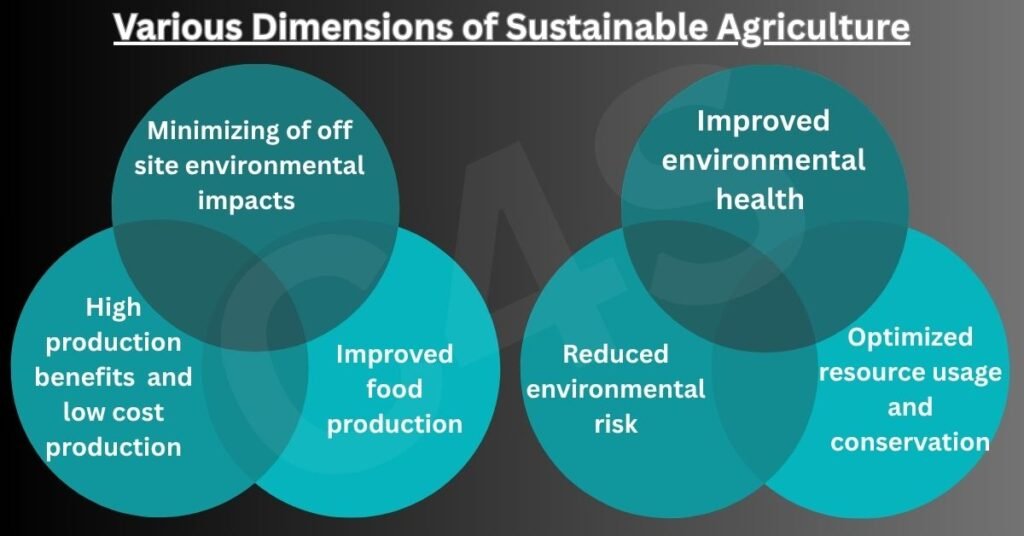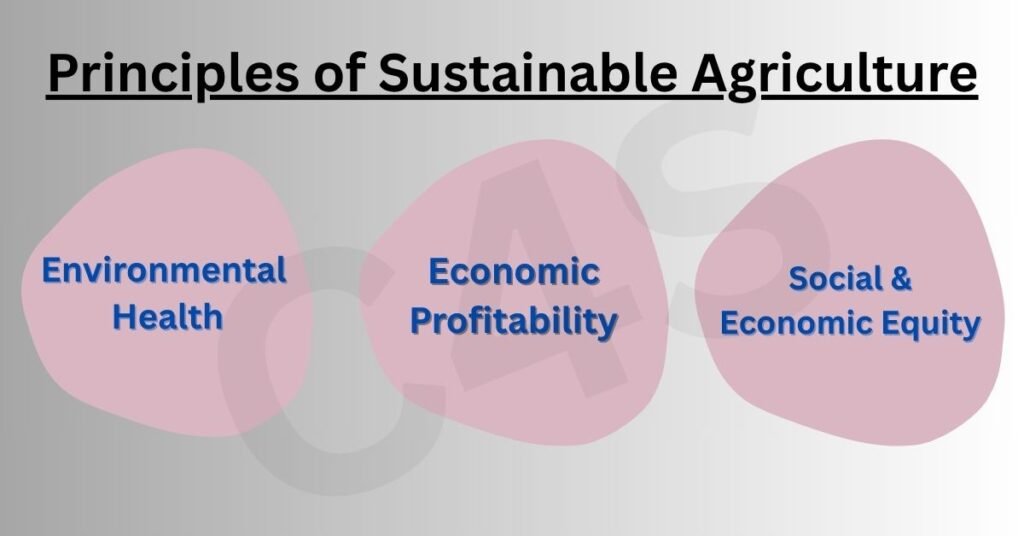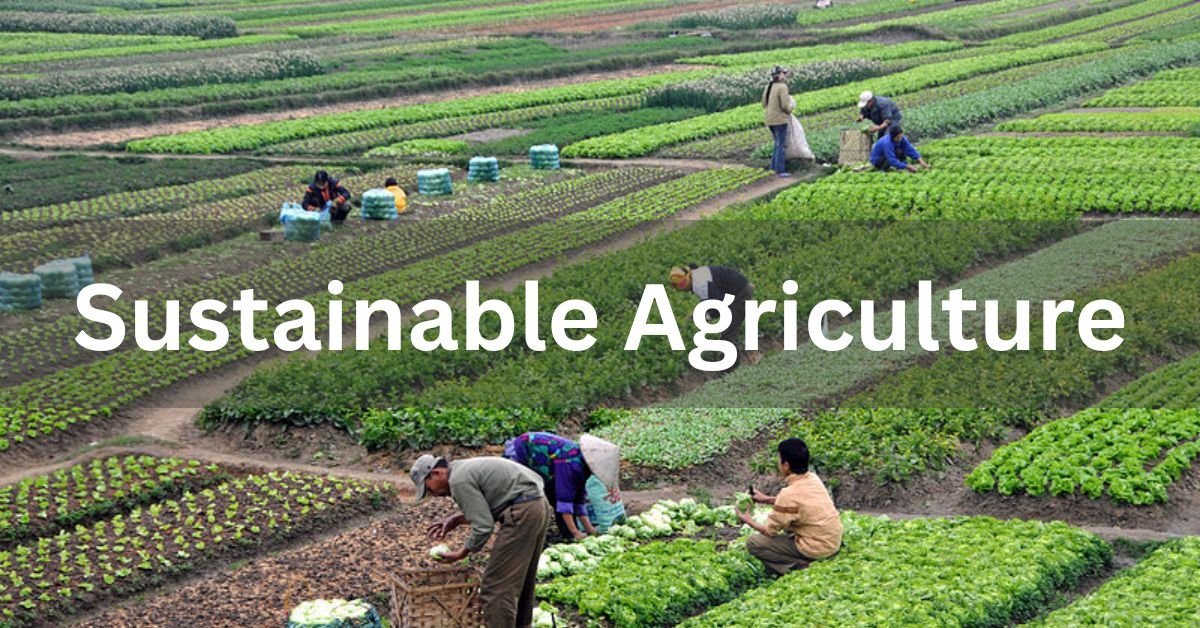Introduction
Sustainable agriculture means growing crops and raising animals in a way that protects the environment, uses natural resources wisely, and helps farmers deal with changes in the climate. The main idea is to produce enough food today without harming the ability of future generations to do the same.
This type of farming focuses on:
- Using water, soil, and energy carefully
- Avoiding damage to the environment
- Reducing pollution and greenhouse gases
- Maintaining biodiversity
- Ensuring long-term productivity of land
A key part of sustainable agriculture is understanding ecosystem services – like how forests help store carbon, how bees pollinate crops, or how healthy soil supports plant growth. These services from nature are essential for farming and must be preserved.
The idea of sustainability in farming became more well-known after the Brundtland Report in 1987, which talked about development that meets today’s needs without compromising the future.

What is Sustainable Agriculture?
- Sustainable agriculture means growing enough food for today’s needs without harming the ability of future generations to do the same. This includes avoiding things like reducing soil fertility or causing permanent damage to the environment.
- It focuses on three main goals: keeping the environment healthy, making farming profitable, and ensuring fairness for all people involved.
- It is seen as a style of farming that uses natural fertilizers like manure, rotates crops, does minimum ploughing, and uses as few chemical fertilizers, pesticides, and antibiotics as possible.
- It’s a balanced way of using and managing natural resources — like soil, animals, forests, plants, fish, and ecosystems — so they continue to give us food and essential services now and in the future.
- Sustainable farming should prevent soil erosion and land damage. It should rely on natural and traditional methods to replace soil nutrients and control weeds, pests, and diseases.
- The biggest threat to sustainable agriculture is the damage and misuse of natural resources.
Principles of Sustainable Agriculture

- Environmental Sustainability:
- This means taking care of nature by protecting, reusing, and restoring natural resources like soil, water, and animals, so they stay healthy and useful for a long time.
- Economic Sustainability:
- This is about making farming more profitable by using methods like better crop rotation and soil care, which help grow more food and improve harvests.
- Social Sustainability:
- This means ensuring fairness in society and keeping cultural traditions and community harmony strong, so everyone benefits from development.
Different Methods of Sustainable Agriculture
- Crop Rotation:
- This is the practice of growing different types of crops in the same field one after another over the years. It helps keep the soil rich in nutrients, reduces soil erosion, and prevents pests and diseases from building up.
- Planting Cover Crops:
- Cover crops are planted during off-seasons when the land would otherwise stay empty. These crops protect the soil from erosion, replenish nutrients, and suppress weed growth, reducing the need for chemical pesticides.
- Biointensive Integrated Pest Management (IPM):
- This approach prevents pest problems by rotating crops, using good microbes that fight plant diseases, and releasing helpful insects that eat pests—without using any harmful chemical pesticides.
- Agroforestry:
- This involves growing trees and shrubs alongside regular crops or grazing areas. It combines both farming and forestry to make land more productive, sustainable, and diverse over the long term.
- Permaculture:
- Permaculture is a thoughtfully designed farming system that copies how natural ecosystems work. The goal is to use land efficiently and sustainably, so it stays productive for growing food and supporting people for generations.
- Organic Farming:
- Organic farming means growing crops naturally without chemicals. It uses things like compost, manure, and helpful microbes to keep the soil healthy and support long-term, eco-friendly farming.
- LEISA (Low External Input Sustainable Agriculture):
- This method uses very little chemical fertilizers and pesticides. Instead, it depends more on natural techniques, good crop management, and local resources to maintain good crop yields.
- Zero Budget Natural Farming:
- This is a type of farming where no loans or outside purchases are needed. Everything is done using natural, homemade inputs, with no chemicals at all—making it cost-free and eco-friendly.
- Biodynamic Agriculture:
- This approach sees the entire farm as one living system. It uses animals to recycle nutrients, follows specific planting calendars, and respects natural and spiritual forces that affect farming.
- Conservation Agriculture:
- This farming method includes keeping the soil covered with organic material, rotating crops for better soil health, and reducing tillage (ploughing), so that soil structure stays intact and productive.
Advantages of Sustainable Agriculture
- Environmental Protection:
- Sustainable agriculture focuses on improving soil health while also protecting nature—this includes clean air, safe water, healthy biodiversity, and a stable climate.
- Saving Energy:
- It promotes using less petroleum-based (fossil fuel) products and encourages the use of energy from renewable sources, like the sun or organic waste.
- Food Security:
- The goal is to make sure everyone gets enough nutritious food, both now and in the future, by growing food in a safe, reliable, and sustainable way.
- Economic Profitability:
- Sustainable farming helps increase production in the long run and makes the farming sector less vulnerable to sudden changes, like price drops or economic shocks.
- Economic and Social Equity:
- It supports fair wages, steady jobs, and safe, decent working conditions for everyone involved in farming and food production.
- Other Benefits:
- It also values the needs, skills, traditions, and systems of the local communities, making farming more people-friendly and culturally respectful.
Challenges of Sustainable Agriculture
- Organic Farming and Food Security:
- As the world’s population keeps growing, there is concern about whether we can produce enough food to feed everyone.
- Switching to organic farming often reduces crop yields compared to modern intensive farming.
- So, to feed the world properly, organic methods need to be combined with other sustainable farming techniques.
- Feasibility of Conservation Agriculture for Soil Management:
- Conservation farming avoids ploughing, which means farmers must change how they control weeds, often using herbicides and special tools for planting.
- For small farmers in developing countries, this is hard to adopt due to cost and equipment issues. That’s why conservation agriculture is more common in places like North America, Europe, and Australia.
- Issues with Small Land Holdings:
- Some experts believe small farms are more eco-friendly and better for the environment than large industrial farms.
- But small farmers can also damage the soil and environment if they lack training or access to modern sustainable practices.
- So, problems like soil damage aren’t limited to large-scale farming — small farms can face them too.
- Debate on High Yield Variety (HYV) Seeds Usage:
- HYV or hybrid seeds help increase food production, but they also come with health, environmental, and economic risks for farmers.
- Still, with the growing need for food security, these seeds are seen as necessary to increase crop output.
- Use of Chemical Pesticides:
- With more insect attacks and crop damage, it may not be possible to completely stop using chemical pesticides.
- Instead, we should focus on using less harmful and more eco-friendly options rather than relying heavily on dangerous chemicals.
Sustainable Agriculture in India
Government Initiatives
- National Mission on Sustainable Agriculture:
- This is one of the eight key missions under India’s National Action Plan on Climate Change (NAPCC).
- Its main goal is to increase farm productivity, especially in areas that depend on rainfall, by promoting integrated farming, better soil health, and efficient use of natural resources.
- Paramparagat Krishi Vikas Yojana (PKVY):
- PKVY aims to promote organic farming on a larger scale by forming groups of farmers who grow crops organically together (called cluster farming).
- These farmers are given training and support to produce organic crops for commercial sale.
- Network Project on Organic Farming of ICAR:
- This ICAR project compares how well organic farming and conventional (chemical-based) farming work in different regions.
- It helps to find out which method is better for crop growth and sustainability based on local conditions.
Other Initiatives
- Sustainable Sugarcane Initiative (SSI):
- The Sustainable Sugarcane Initiative is a method to grow more sugarcane while using fewer seeds, less water, and making the best use of fertilizers and land. It helps increase production efficiently and sustainably.
- System of Rice Intensification (SRI):
- SRI is a farming technique for rice that changes how farmers manage plants, soil, water, and nutrients to grow more rice.
- It uses less water, needs young seedlings, and the plants are spaced out more than usual. Though it takes more time and effort, it gives better yields.
- In India’s Cauvery delta, a local version of this method is called the Kadiramangalam System of Rice Intensification.
Challenges to Sustainable Agriculture in India
Rising Population and Degraded Ecosystems:
With more people and damaged natural environments, farmers have relied heavily on intensive farming methods like HYV seeds and chemical fertilizers, along with deforestation, to keep up with food demand.
Lack of Capital:
Many small and medium farmers don’t have enough money or financial support to switch from traditional methods to sustainable farming.
Lack of Access to Information & Technology:
Farmers often don’t have proper knowledge, tools, or technology to improve how they grow, process, or sell their crops using modern, sustainable techniques.
Lack of Economic Incentives:
Because there are no clear rewards or financial support, many farmers are uncertain or hesitant about shifting to sustainable farming practices.
Lack of Public Policy & Infrastructure:
There aren’t enough government policies, support systems, or basic infrastructure to help and encourage farmers to adopt eco-friendly farming methods.
Strategies for Making Agriculture More Sustainable
- Appropriate Production Systems:
- To make farming more sustainable, agriculture policies should match local natural conditions.
- For example, in dry regions, we should encourage dryland farming and promote less water-consuming crops like millets and pulses, instead of water-heavy crops.
- Crops like rice, which need a lot of water, should be grown in areas with more water availability.
- Polycultures and Crop Rotation:
- Instead of growing the same crop again and again (monoculture), farmers should grow different crops together or in rotation.
- This reduces the need for chemical fertilizers and pesticides, improves soil health, and supports biodiversity.
- Such diverse farming systems are more productive, require more human involvement, and offer better natural benefits, making them more sustainable.
- Emphasis on Nurturing the Soil:
- Focusing on taking care of the soil, rather than just growing the plants, leads to better crop yields, healthier ecosystems, and helps store carbon in the soil – which is good for fighting climate change.
- Promotion of Zero Budget Natural Farming:
- Programs like Zero Budget Natural Farming (ZBNF) help farmers grow food with very low costs and no chemical inputs.
- This can restore soil and ecosystem health while also giving small farmers more ways to earn and sustain their livelihood.
- Reducing Food Waste and Promoting Sustainable Consumption Patterns:
- To stop food from being wasted, we need better storage, harvesting methods, and transport in rural areas.
- Also, encouraging people to consume food responsibly helps create a more sustainable food system.
Conclusion
Sustainable agriculture needs to balance social, economic, and environmental goals — all three are equally important. With the population growing, natural resources running out, and the threat of climate change increasing, we won’t be able to meet the food needs of the future unless we shift to more sustainable ways of farming. This means building food systems that can feed everyone, create jobs and income, and protect the environment and natural resources that we all depend on.
MCQ’s
1. Which of the following is a core objective of sustainable agriculture?
A. Maximizing crop yields
B. Reducing food prices
C. Maintaining soil fertility
D. Increasing pesticide use
Answer: (C) See the Explanation
Sustainable agriculture aims to maintain soil fertility through crop rotation, organic inputs, and conservation techniques.2. What is the significance of crop rotation in sustainable agriculture?
A. Prevents erosion
B. Enhances soil nutrients
C. Reduces pests
D. All of the above
Answer: (D) See the Explanation
Crop rotation helps prevent soil erosion, maintains nutrient balance, and controls pest populations.3. Which method is NOT typically associated with sustainable agriculture?
A. Agroforestry
B. Intensive monoculture
C. Permaculture
D. Organic farming
Answer: (B) See the Explanation
Intensive monoculture depletes soil nutrients and relies heavily on chemical inputs, opposing sustainable practices.4. Which government initiative supports sustainable agriculture in India?
A. Green Revolution
B. National Mission on Sustainable Agriculture
C. Make in India
D. Swachh Bharat Abhiyan
Answer: (B) See the Explanation
The National Mission on Sustainable Agriculture (NMSA) promotes sustainable practices like soil health management and resource conservation.5. What is a key challenge for sustainable agriculture in India?
A. Excess rainfall
B. Lack of modern technology
C. Small land holdings
D. Surplus food production
Answer: (C) See the Explanation
Small land holdings limit the application of advanced sustainable techniques, making it challenging for farmers to adopt best practices.
FAQ’s
Q: What is sustainable agriculture?
Answer: Sustainable agriculture means growing food in a way that keeps the land healthy, protects the environment, and uses fewer harmful chemicals, while still producing enough to feed people.
Q: What are the main principles of sustainable agriculture?
Answer: It is based on three key ideas — protecting nature, supporting farmers’ incomes, and treating people fairly. The goal is to keep farming going strong for the long term.
Q: How does sustainable agriculture protect the environment?
Answer: It helps the environment by using fewer chemicals, rotating crops, keeping soil healthy, and using water carefully.
Q: What are the benefits of organic farming within sustainable agriculture?
Answer: Organic farming makes the soil healthier, reduces pollution, protects wildlife, and gives people cleaner, safer food to eat.
Q: How does sustainable agriculture address climate change?
Answer: It helps farmers cope with climate change by using better water systems, protecting the soil, and supporting more plant and animal diversity on farms.
















